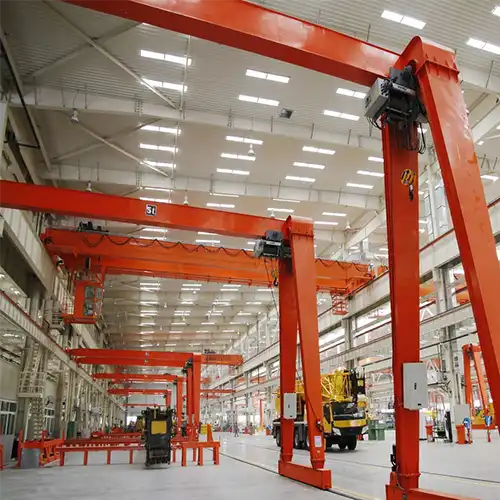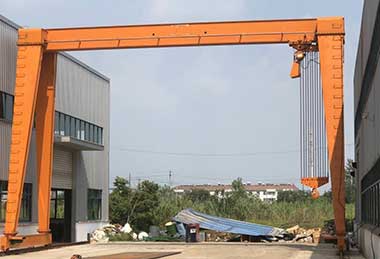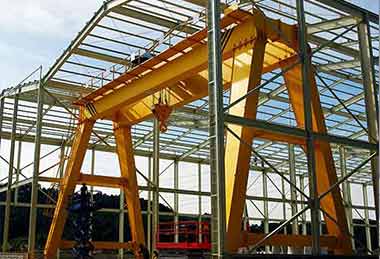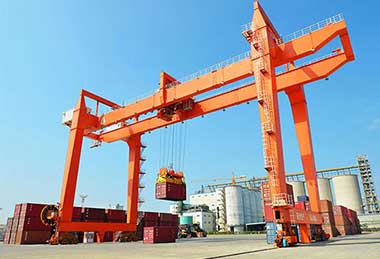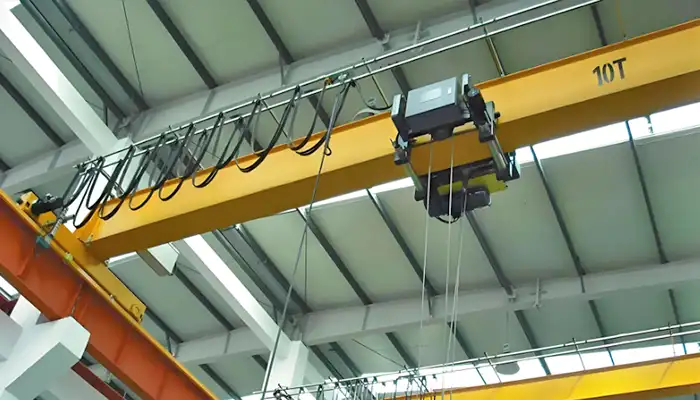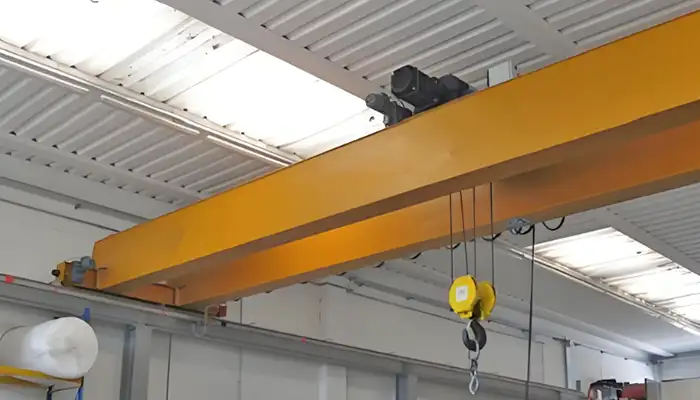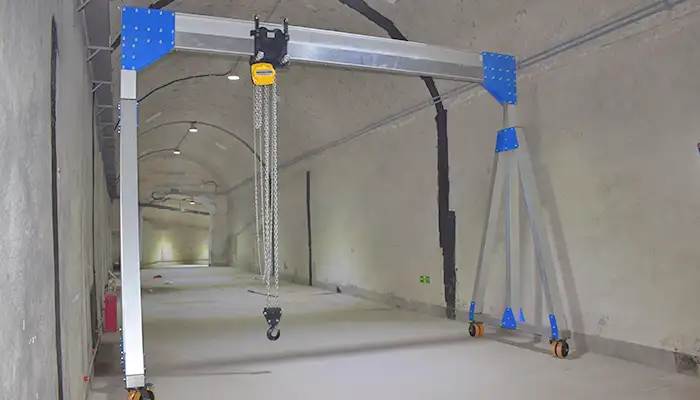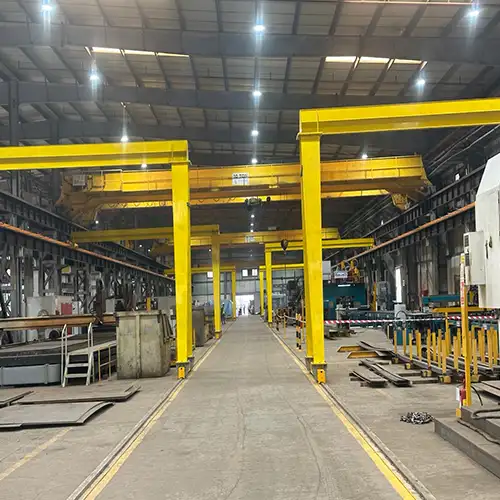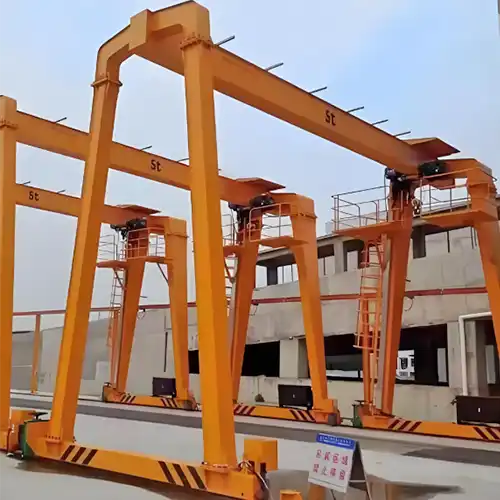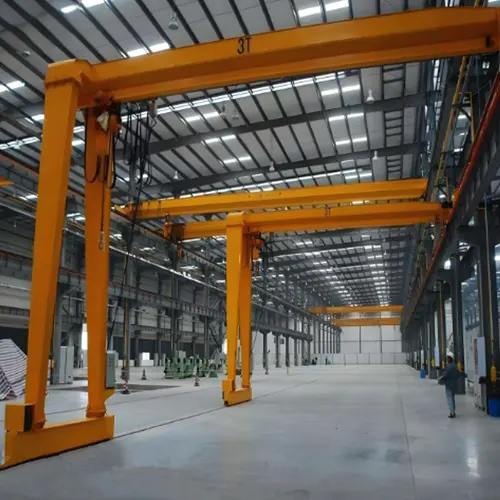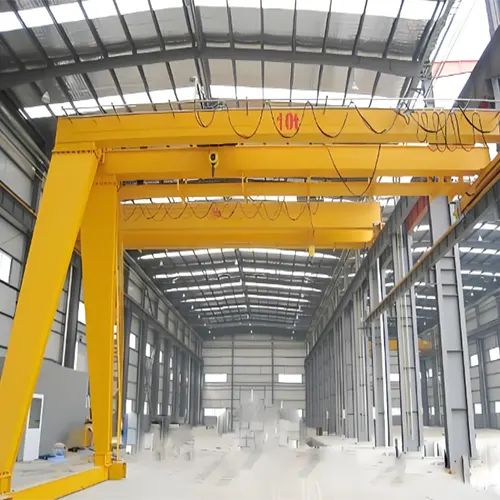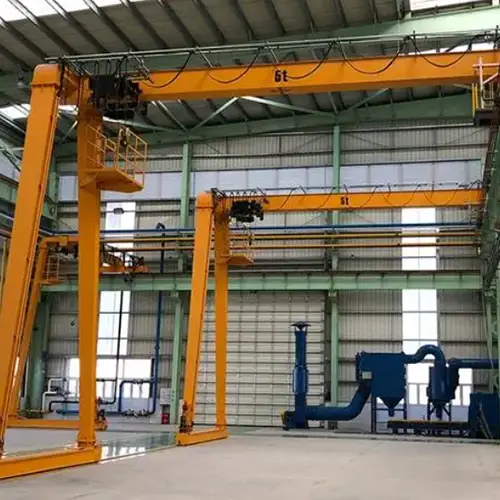Why Semi Gantry Crane Over Full Gantry or Overhead Crane?
Choose semi gantry crane for efficient space use, cost savings & flexibility over full gantry or overhead crane. Get your semi gantry crane at good price!
Category: Full& Half Gantry
Your Trusted Semi Gantry Crane Manufacturer & Supplier
Why Semi Gantry Crane Over Full Gantry or Overhead Crane?
Choose Semi Gantry Crane for Efficient Space Use, Cost Savings & Flexibility Over Full Gantry or Overhead Crane
Why Semi Gantry Crane Over Full Gantry or Overhead Crane?
Choose semi gantry crane for efficient space use, cost savings & flexibility over full gantry or overhead crane. Get your semi gantry crane at good price!
Why Semi Gantry Crane Over Full Gantry or Overhead Crane?
In the field of industrial material handling, the choice between semi gantry cranes, full gantry cranes, and overhead cranes hinges on distinct design features and operational considerations.
- Semi gantry cranes feature a single leg supported on ground-level tracks, offering flexibility in installation and adaptability to uneven terrain or confined spaces. This design makes them cost-effective alternatives for industries needing moderate lifting capacities without the space or cost requirements of full gantry cranes.
- Full gantry cranes, distinguished by two legs traversing elevated runways spanning the workspace, excel in stability and heavy lifting capabilities. They provide comprehensive coverage and unrestricted movement, ideal for large-scale manufacturing and outdoor applications where precise load handling is essential.
- Overhead cranes are suspended from elevated runways or ceilings, optimizing vertical space utilization in indoor environments. Known for their efficiency in repetitive tasks and maximizing floor space, they are favored in industries requiring precise material handling and assembly operations.
Choosing the right crane type is crucial to optimizing operational efficiency and cost-effectiveness, aligning with specific industry needs and workspace constraints. Each crane type offers distinct advantages that cater to different operational environments, emphasizing the importance of a tailored selection process to meet unique operational demands effectively.
Overview of Semi Gantry Cranes: Features, Benefits, and Typical Applications

Single Girder Semi Gantry Crane with A Frame Gantry Crane
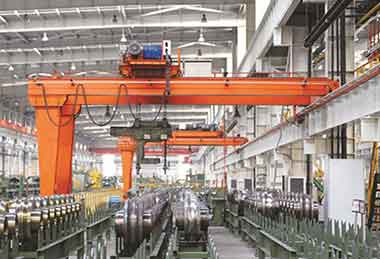
Double Girder Semi Gantry Cranes with A Frame Gantry Crane

Semi Gantry Cranes with U Frame Gantry Design
Features of Semi Gantry Cranes:
Semi gantry cranes are distinguished by their innovative design, combining robust functionality with adaptability to diverse operational environments:
- Single-leg support: Ensures stability with one end supported by a ground-level leg, reducing the requirement for extensive runway structures typically associated with full gantry cranes.
- Modular design: Facilitates customization to accommodate different workspace configurations, allowing for optimal integration into existing layouts and operational needs.
- Flexibility: Ideal for navigating uneven terrain and fitting into restricted spaces where the installation of full gantry cranes may pose challenges. This adaptability enhances operational efficiency across industries ranging from manufacturing to construction, supporting versatile material handling tasks with precision and reliability.
Benefits of Semi Gantry Cranes:
- Cost-effectiveness: Semi gantry cranes offer a more economical solution with lower initial investment and reduced maintenance costs compared to full gantry cranes, making them accessible for medium-duty lifting tasks.
- Adaptability: Their modular design allows for easy installation, relocation, and adjustment, which is advantageous in temporary or evolving work environments. This flexibility ensures that operational needs can be met efficiently without significant downtime or disruption.
- Space efficiency: By utilizing a single supporting leg and ground-level tracks, semi gantry cranes optimize ground space utilization. They provide robust lifting capabilities while requiring less structural support than full gantry cranes, making them suitable for facilities with space constraints or limited overhead clearance.
These benefits collectively enhance productivity and operational efficiency across various industries, offering reliable performance in material handling tasks while maintaining cost-effectiveness and adaptability to changing operational demands.
Where Semi Gantry Cranes are Preferred:
Semi gantry cranes are particularly favored in various industrial settings for several reasons:
- Space constraints: In facilities with limited floor space or height restrictions, semi gantry cranes provide a practical solution. Unlike full gantry cranes that require support structures on both ends, semi gantry cranes use a single leg support, reducing the overall footprint and allowing installation in tighter spaces.
- Flexibility in installation: Their modular design enables easy setup and relocation, making them suitable for temporary projects or environments where operational needs may change over time. This flexibility is advantageous in dynamic workplaces such as construction sites or manufacturing facilities undergoing layout modifications.
- Cost considerations: Semi gantry cranes offer a cost-effective alternative, especially for medium-duty lifting tasks. They require less initial investment compared to full gantry cranes due to simpler installation requirements and reduced infrastructure costs. Despite their affordability, they maintain high operational efficiency, ensuring optimal performance in handling materials and components within specified weight capacities.
These factors collectively position semi gantry cranes as versatile and practical solutions across industries, addressing specific challenges related to space, installation flexibility, and budget constraints while supporting efficient material handling operations.
Comparative Analysis
Semi Gantry Cranes
Design Characteristics:
Semi gantry cranes are distinguished by their efficient and adaptable design:
- Single Leg Support: One end of the crane is supported by a single leg, while the other end travels along ground-level tracks. This design provides stability and reduces the need for extensive runway structures, optimizing space utilization.
- Modular and Adaptable: Known for their flexibility, semi gantry cranes can be easily customized to fit various workspace configurations. This modular approach allows for quick installation and adaptation to different operational requirements, making them suitable for both permanent and temporary applications.
Advantages over Full Gantry and Overhead Cranes:
- Cost-effectiveness: Semi gantry cranes offer lower initial investment and maintenance costs compared to full gantry cranes and overhead cranes. This affordability makes them accessible for industries seeking efficient material handling solutions without extensive financial outlay.
- Flexibility: Designed to navigate uneven terrain and accommodate restricted workspaces, semi gantry cranes provide operational flexibility where full gantry cranes may be impractical due to space constraints or ground conditions.
- Ease of Installation and Relocation: Semi gantry cranes are easier to install and relocate compared to full gantry cranes, thanks to their modular design and simplified structural requirements. This feature enhances operational agility, allowing businesses to adapt quickly to changing production demands or site layouts.
Suitable Applications:
- Construction: Used for lifting and transporting materials across construction sites with varying ground conditions and limited space availability.
- Workshops: Ideal for supporting manufacturing processes by facilitating efficient material handling within confined or irregularly shaped work areas.
- Manufacturing: Applied in production environments to streamline operations and enhance workflow efficiency, particularly in settings requiring frequent layout adjustments or temporary installations.
By leveraging these advantages, semi gantry cranes prove beneficial in enhancing productivity, optimizing operational costs, and addressing specific logistical challenges across diverse industrial applications.
Full Gantry Cranes
Key Features:
Full gantry cranes are characterized by their robust design and capabilities:
- Dual-leg Structure: Supported by two legs running on elevated runways that span the entire workspace. This configuration provides stability and structural integrity necessary for lifting heavy loads.
- High Lifting Capacity: Designed to handle substantial weights, full gantry cranes are equipped with mechanisms and structures capable of lifting and transporting large, bulky items with precision and safety.
Advantages:
- Comprehensive Coverage: Full gantry cranes offer complete and unrestricted movement within the workspace, ensuring efficient material handling across large areas. This capability is essential for industries requiring extensive reach and maneuverability, such as large-scale manufacturing facilities and shipyards.
- Suitability for Heavy-duty Applications: Ideal for lifting heavy loads in industries where robust lifting solutions are critical, such as steel fabrication, shipbuilding, and outdoor construction projects.
- Versatility: They can be adapted for both indoor and outdoor operations, providing flexibility in handling various materials and accommodating diverse operational environments.
Considerations:
- Higher Initial Investment: Full gantry cranes involve a significant initial investment due to their complex structure, specialized components, and higher engineering requirements compared to semi gantry cranes.
- Space Requirements: Their expansive footprint and elevated runway structures necessitate sufficient space for installation, limiting their feasibility in compact or spatially restricted environments where semi gantry cranes may offer a more practical solution.
- Operational Maintenance: Maintenance of full gantry cranes requires regular inspections and upkeep of elevated runways, structural components, and lifting mechanisms to ensure continued operational reliability and safety.
Full gantry cranes are pivotal in industries demanding robust lifting capabilities and extensive operational coverage. Despite higher initial costs and space considerations, their ability to handle heavy loads and provide unrestricted movement makes them indispensable for large-scale manufacturing and industrial applications requiring reliable and efficient material handling solutions.
Semi Gantry Crane Advantages over Full Gantry Cranes
Cost-effectiveness:
- Semi Gantry Cranes: Offer a more economical solution with lower initial investment and maintenance costs due to their simpler structure and reduced infrastructure requirements.
- Full Gantry Cranes: Require a higher upfront investment due to their complex dual-leg design and elevated runway construction, leading to increased installation and operational expenses.
Flexibility in Installation:
- Semi Gantry Cranes: Can be easily installed and relocated, thanks to their modular design and single-leg support that operates on ground-level tracks. This flexibility allows for adaptability to varying workspace configurations and operational needs.
- Full Gantry Cranes: Require substantial groundwork and structural preparation for installing elevated runways, limiting their adaptability and flexibility in changing environments or temporary setups.
Space Utilization:
- Semi Gantry Cranes: Optimize ground space utilization by minimizing the footprint of supporting structures, making them suitable for facilities with space constraints or irregular layouts.
- Full Gantry Cranes: Occupy significant floor and airspace, requiring ample space for both the crane structure and its operational range. This makes them ideal for large-scale manufacturing or outdoor applications with extensive lifting requirements.
Operational Versatility:
- Semi Gantry Cranes: Excel in navigating uneven terrain and accommodating restricted workspaces where full gantry cranes may be impractical or overly cumbersome.
- Full Gantry Cranes: Provide comprehensive coverage and unrestricted movement within the workspace, making them suitable for handling heavy loads and performing precise maneuvers over a wide operational area.
Maintenance and Accessibility:
- Semi Gantry Cranes: Typically involve simpler maintenance routines due to their accessible ground-level components, facilitating easier inspections and repairs compared to full gantry cranes with elevated structures.
- Full Gantry Cranes: Require specialized maintenance procedures for elevated runways and dual-leg support systems, necessitating careful attention to structural integrity and operational safety.
In summary, while full gantry cranes offer robust lifting capabilities and extensive operational coverage, semi gantry cranes provide a cost-effective alternative with greater flexibility in installation, space utilization, and maintenance. The choice between these crane types hinges on specific operational requirements, spatial constraints, and budget considerations within industrial settings.
Overhead Bridge Cranes
Overhead cranes are defined by their suspended configuration, utilizing either a ceiling-mounted or elevated runway structure. Key characteristics include:
- Suspended Design: These cranes operate by being mounted overhead, allowing for efficient use of vertical space without occupying valuable floor area.
- Versatility: Designed to handle various load capacities and sizes, overhead cranes are adaptable to different industrial applications, from light-duty to heavy-duty lifting tasks.
Advantages:
- Precision and Efficiency: Overhead cranes excel in precise and repetitive lifting operations, crucial for industries requiring accurate positioning of materials or components.
- Floor Space Optimization: By operating overhead, these cranes maximize floor space utilization, enabling seamless workflow and operational efficiency within confined indoor environments.
Limitations:
- Indoor Restriction: Primarily suited for indoor environments due to their ceiling or runway-mounted configuration, limiting their use in outdoor settings where infrastructure may not support overhead installation.
- Installation Complexity: Setting up overhead cranes involves higher complexity compared to ground-based alternatives, necessitating robust structural support and careful planning during installation and maintenance.
Overhead cranes are preferred in manufacturing, assembly lines, and warehouses where precise material handling and space optimization are paramount. Despite their indoor confinement and installation challenges, their efficiency and versatility make them indispensable tools in modern industrial operations.
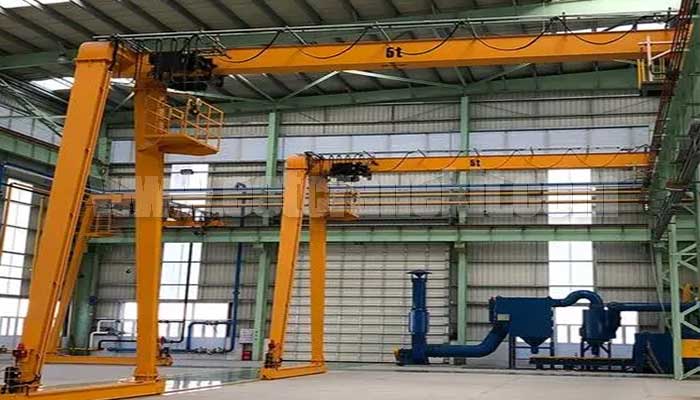
single girder semi gantry crane
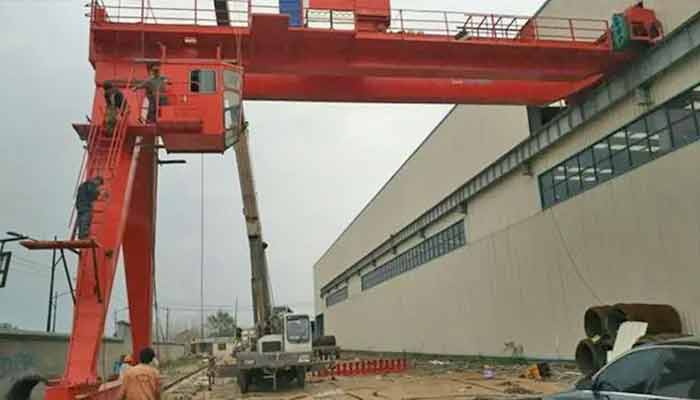
double girder semi gantry crane
Semi Gantry Crane Advantages over Overhead Bridge Cranes
Cost-effectiveness:
- Lower Initial Investment: Semi gantry cranes generally require less upfront capital compared to overhead bridge cranes due to their simpler structural requirements and easier installation process.
- Reduced Maintenance Costs: With ground-level components and simpler design, semi gantry cranes often incur lower maintenance expenses over their operational lifespan.
Flexibility in Installation and Use:
- Adaptability to Varied Environments: Semi gantry cranes are easier to install and relocate, making them suitable for environments with uneven terrain or limited overhead clearance where overhead bridge cranes may be impractical.
- Modular Design: Their modular construction allows for customization to fit specific workspace configurations and operational needs, providing flexibility in layout and use.
Space Utilization:
- Ground Space Optimization: Semi gantry cranes optimize ground-level space utilization, making them ideal for facilities with space constraints or irregular layouts where overhead bridge cranes would occupy valuable floor space.
- Minimal Structural Footprint: They have a smaller footprint compared to overhead bridge cranes, allowing for efficient use of available space without compromising lifting capacity.
Operational Versatility:
- Handling of Uneven Terrain: Semi gantry cranes excel in environments with uneven surfaces or restricted workspace, offering stability and operational efficiency where overhead bridge cranes may struggle.
- Flexibility in Application: They are suitable for a variety of industries and applications, including construction sites, workshops, and warehouses, where their adaptability enhances overall operational productivity.
Maintenance Accessibility:
- Ease of Maintenance: Semi gantry cranes typically have accessible ground-level components, facilitating easier maintenance procedures compared to overhead bridge cranes that require specialized access to elevated structures.
- Lower Downtime: Simplified maintenance routines contribute to reduced downtime, ensuring continuous operational efficiency and minimal disruption to workflow.
In conclusion, semi gantry cranes offer distinct advantages over overhead bridge cranes in terms of cost-effectiveness, installation flexibility, space utilization, operational versatility, and maintenance accessibility. These factors make them a preferred choice for many industrial applications where efficiency, adaptability, and budget considerations are paramount.
Operational Environment and Space Constraints:
When selecting between semi gantry cranes and overhead bridge cranes, several key factors related to the operational environment and space constraints should be considered:
- Analysis of Workspace Layout: Evaluate the layout of the workspace, including the size and shape of the area where the crane will operate. Semi gantry cranes, with their ground-level support and ability to operate on tracks, are suitable for environments with irregular layouts or limited ground space availability.
- Available Floor Area: Assess the amount of floor space available for crane installation and operation. Semi gantry cranes typically have a smaller footprint compared to overhead bridge cranes, making them advantageous in facilities where maximizing ground-level space is crucial for other operational activities.
- Ceiling Height and Clearance: Consider the height of the facility's ceiling or overhead clearance. Overhead bridge cranes require sufficient overhead space for installation and operation, whereas semi gantry cranes operate closer to ground level, reducing the requirement for high ceiling clearance.
- Compatibility with Existing Infrastructure: Evaluate the compatibility of each crane type with existing infrastructure, such as building columns, beams, and other structural elements. Semi gantry cranes may offer more flexibility in adapting to existing layouts and structures without extensive modifications.
- Operational Workflow: Analyze the operational workflow and material handling needs within the facility. Semi gantry cranes, with their flexibility in installation and use, are suitable for environments requiring frequent layout adjustments or where materials need to be moved across varying terrain conditions.
By carefully assessing these factors, including workspace layout, available floor area, ceiling height, compatibility with existing infrastructure, and operational workflow requirements, businesses can make an informed decision on whether semi gantry cranes or overhead bridge cranes best align with their operational needs and spatial constraints.
Factors Influencing Selection
Load Capacity and Handling Requirements:
When choosing between semi gantry cranes and overhead bridge cranes, consider the following factors related to load capacity, handling requirements, and operational efficiency:
- Maximum Load Capacity: Evaluate the maximum weight that the crane will need to lift and transport. Overhead bridge cranes typically offer higher load capacities compared to semi gantry cranes, making them suitable for heavy-duty lifting applications.
- Frequency of Lifts: Assess how often the crane will be used and the frequency of lifts. Overhead bridge cranes, with their efficient vertical lifting capabilities, are ideal for applications requiring frequent and repetitive lifts.
- Operational Efficiency: Compare performance metrics such as lifting speed, precision, and maneuverability across crane types. Overhead bridge cranes are known for their precise movement and efficient material handling in indoor environments, optimizing operational efficiency.
Cost Considerations:
Cost is a critical factor when deciding between semi gantry cranes and overhead bridge cranes. Conduct a detailed cost-benefit analysis considering:
- Initial Investment: Evaluate the upfront costs associated with purchasing and installing the crane. Overhead bridge cranes generally require a higher initial investment due to their complex installation and structural requirements.
- Maintenance Costs: Compare ongoing maintenance expenses for each crane type. Semi gantry cranes often have lower maintenance costs due to their simpler design and accessibility of ground-level components.
- Long-term Operational Expenses: Consider operational expenses such as energy consumption, repairs, and potential downtime. Assess how each crane type contributes to overall operational costs over its lifespan.
- Return on Investment (ROI): Calculate the ROI based on the crane's lifespan, operational uptime, and efficiency improvements. Overhead bridge cranes may offer a higher ROI in applications requiring heavy lifting and precise material handling.
By conducting a thorough evaluation of load capacity, handling requirements, operational efficiency, initial investment, maintenance costs, and long-term operational expenses, businesses can make an informed decision on whether semi gantry cranes or overhead bridge cranes are the optimal choice for their specific industrial applications and budget constraints.
Case Studies and Practical Examples
Real-world applications where semi gantry cranes provided superior solutions:
Semi gantry cranes have demonstrated their effectiveness and versatility across various industries, offering cost savings, operational flexibility, and efficiency gains in practical applications. Here are some case studies highlighting their advantages:
- Construction Industry: In urban construction sites with limited ground space and irregular layouts, semi gantry cranes have proven invaluable. They facilitate efficient material handling and equipment movement without obstructing other construction activities. Case studies show significant cost savings due to reduced installation time and simplified maintenance compared to traditional overhead cranes.
- Manufacturing Facilities: Semi gantry cranes are widely adopted in manufacturing plants for their ability to adapt to changing production layouts and handle diverse load capacities. They enhance operational efficiency by minimizing downtime during layout adjustments and offering precise material handling capabilities. Case studies illustrate improved workflow and productivity metrics through streamlined operations and optimized space utilization.
- Warehouse and Logistics: In warehouse operations, semi gantry cranes optimize storage and retrieval processes by efficiently moving goods across storage racks and loading areas. They excel in environments where rapid inventory turnover and space efficiency are critical. Case studies highlight enhanced inventory management and fulfillment speed, resulting in improved customer satisfaction and operational profitability.
- Shipbuilding and Repair: Semi gantry cranes are used in shipyards for their ability to maneuver heavy ship components and facilitate assembly operations. They provide stability and flexibility in handling large structures, contributing to safer working conditions and accelerated project timelines. Case studies demonstrate reduced project lead times and enhanced safety records through effective load management and operational control.
- Specialized Applications: Semi gantry cranes are also employed in specialized industries such as renewable energy projects and aerospace manufacturing. They support unique operational requirements with tailored configurations and advanced lifting capabilities. Case studies showcase successful implementations in challenging environments, ensuring compliance with stringent safety standards and achieving project milestones on schedule.
These case studies underscore the diverse benefits of semi gantry cranes across different sectors, highlighting their cost-effective solutions, operational flexibility, and efficiency improvements in real-world applications. By leveraging their adaptability and performance advantages, businesses can achieve significant operational enhancements and competitive advantages in their respective industries.
Conclusion
In conclusion, semi gantry cranes offer significant advantages over both full gantry cranes and overhead cranes, making them a preferred choice in various industrial applications. Throughout this exploration, several key insights highlight their comparative strengths:
- Cost-effectiveness: Semi gantry cranes provide a cost-effective solution with lower initial investment and maintenance costs compared to full gantry cranes and overhead cranes. This makes them an attractive option for businesses looking to optimize operational expenses without compromising on performance.
- Flexibility and Adaptability: With their modular design and ground-level support, semi gantry cranes offer flexibility in installation, relocation, and adaptation to diverse operational environments. They excel in handling uneven terrain and restricted workspaces where full gantry cranes and overhead cranes may pose logistical challenges.
- Operational Efficiency: Semi gantry cranes optimize space utilization while maintaining robust lifting capabilities. They are efficient in material handling processes, enhancing productivity and workflow efficiency across industries such as construction, manufacturing, and logistics.
For crane suppliers and manufacturers, understanding these comparative advantages is crucial for strategic positioning in the market:
- Product Differentiation: Emphasize the unique benefits of semi gantry cranes, such as cost-effectiveness, flexibility, and operational efficiency, in marketing and sales efforts. Highlight case studies and customer testimonials showcasing successful implementations and performance metrics.
- Customer-centric Solutions: Tailor semi gantry crane designs to meet specific customer needs and operational requirements. Offer customizable options, technological integrations like IoT for predictive maintenance, and safety enhancements to enhance customer satisfaction and loyalty.
By focusing on these strategic considerations, crane suppliers and manufacturers can effectively position semi gantry cranes as versatile and high-performance solutions in the competitive industrial crane market. This approach not only drives business growth but also supports sustainable partnerships and long-term success in meeting customer demands.
Key Takeaways for Crane Suppliers and Manufacturers
As crane suppliers and manufacturers navigate the competitive landscape, focusing on the following key takeaways can enhance market positioning and customer engagement:
- Customization and Adaptability: Highlight the flexibility of semi gantry cranes in adapting to diverse customer requirements and operational environments. Offer modular designs and customizable features that cater to specific lifting capacities, spatial constraints, and industry applications.
- Value Proposition: Emphasize the compelling benefits of semi gantry cranes, such as cost-effectiveness in initial investment and maintenance, ease of installation, and operational efficiency. Position these advantages as value-added propositions that resonate with potential customers seeking reliable and economical material handling solutions.
- Innovation and Technology: Showcase ongoing advancements in semi gantry crane technology to demonstrate commitment to innovation and industry leadership. Integrate IoT capabilities for predictive maintenance, incorporate lightweight materials for enhanced efficiency, and develop safety enhancements to ensure compliance with rigorous industry standards.
By focusing on these strategic pillars—customization and adaptability, value proposition, and innovation and technology—crane suppliers and manufacturers can effectively differentiate their offerings in the market. This approach not only attracts new customers but also fosters long-term partnerships based on trust, reliability, and continuous improvement in crane solutions.
Main Projects
Related Products
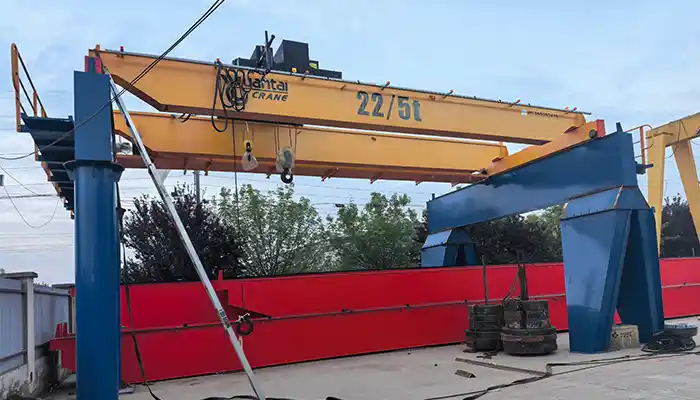
22/5 Ton Overhead Crane Double Hook System: Robust double girder crane with 22-ton main and 5-ton auxiliary hooks for heavy lifting. Get double hook crane!
Free consultation to Confirm Parameters & Specifications and Get
Latest Crane Price & Crane Rate.
- Types of overhead cranes : _______?
- Optional: Overhead travelling crane, goliath gantry crane,Slewing jib crane, Single girder or double girder crane,small portable crane or kbk crane, etc.
- Capacity of overhead crane: _______?
- Optional: 0.25ton, 0.5 ton, 1 ton, 2 ton, 3ton, 5 ton, 10 ton,15ton, 20ton, 25 ton, 30ton,35ton, up to 550ton, etc.
- Crane span & lifting height : _______?
- Crane travelling length : _____?
- Control of overhead crane:_______?
- Optional: pendant/ remote/cabin control
- Voltage supply of overhead crane:_____?
- Eg,: 380V50/60HZ,3Phase or others,etc.
- Application/usage of crane:_______?
- Eg,: Steel mill, ,injection mold, cement,stone, concrete,granite, general manufacturing, etc.
Just leave a message via the contact form and our hoist and crane engineer will contact you with in 24working hours.
Get In Touch
